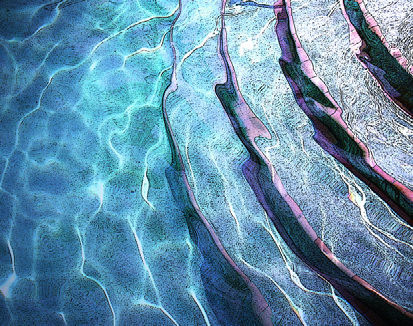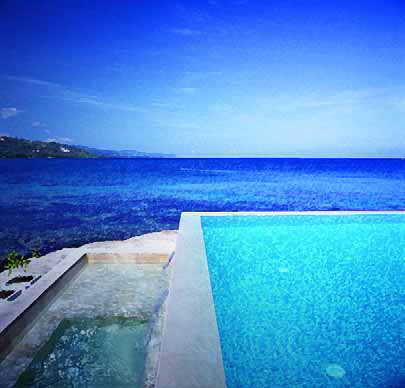pool design
As custom watershapers, we all know that each combination of client and project presents a unique profile with respect to scope, design goals and the overall mission. In the project seen here, however, that common formulation was elevated by virtue of the fact that we were working with an accomplished architect on what was to be his own home. He came to the table with strong, distinct ideas about style and project direction, but he was also willing to collaborate with us when it came to the details and practicalities of developing a watershape composition that suited both his needs and a spectacular setting. The property - a gently sloping two-acre lot - is located in an exclusive neighborhood in San Marino, Calif., and our work there took place in concert with construction of a gorgeous new home in a classic Mediterranean style. My company, Arcadia Pools & Spas of Arcadia, Calif., had worked with the architect before on a fountain for a commercial property, so we
As custom watershapers, we all know that each combination of client and project presents a unique profile with respect to scope, design goals and the overall mission. In the project seen here, however, that common formulation was elevated by virtue of the fact that we were working with an accomplished architect on what was to be his own home. He came to the table with strong, distinct ideas about style and project direction, but he was also willing to collaborate with us when it came to the details and practicalities of developing a watershape composition that suited both his needs and a spectacular setting. The property - a gently sloping two-acre lot - is located in an exclusive neighborhood in San Marino, Calif., and our work there took place in concert with construction of a gorgeous new home in a classic Mediterranean style. My company, Arcadia Pools & Spas of Arcadia, Calif., had worked with the architect before on a fountain for a commercial property, so we
In a couple of my recent "Details," I've discussed the early stages of a wonderful project located on the waterfront of Long Beach Island, N.J. As is the case with many top-level jobs, this one required a great deal of work in the early going to make sure we were set up for complete success once the installation process was under way and the pool, spa and surrounding structures began to come together. Although the pool in question is a simple rectangle designed to function mainly as a subtle and elegant reflective surface, there are certain features within the "shape" of the shell that make it something special - and particularly relevant to how the clients
It's easy to talk about watershapes and the creative and business philosophies that drive success, but to borrow a phrase: The proof is in the pool. In other words, it's one thing to talk about doing a good job, but it's another to step up and do it. The dynamics of that success are unusually complex when you participate in a project as the member of a team. As a case in point, I'll return to a semi-public watershape I first mentioned in my March 2006 column: It's now complete and is one of which I'm particularly proud. Located in Jamaica near Montego Bay at a property known as the Round Hill Hotel & Villas, it was a special sort of commercial project in that, being built outside the United States, it wasn't subject to
In last month's "Detail," I discussed the beginning stages of a new project that has my partner Kevin Fleming and me pretty excited. At this point, the pool's been shot and we're moving along at a good pace. I'll pick up that project again in upcoming issues, but I've brought it up briefly here to launch into a discussion about something in our industry that mystifies me almost on a daily basis. So far, the work we've done on the oceanfront renovation project has been focused on a relatively narrow band of design considerations having to do with the watershape and its associated structures. This focus is
Working in constrained spaces is entirely different from tackling projects that unfold in pastures where the only boundary might be a distant mountain or an ocean view. Indeed, in small areas that may be defined by fencing or walls or adjacent structures, the constrained field of view offers substantial aesthetic challenges to the designer in that every detail, each focal point, all material and color selections and every visual transition will be seen, basically forever, at very close range. When you're working small spaces, in other words, there's literally not much room for error. In this smaller context, each and every decision watershapers and clients make will subsequently be in direct view, and it's likely that each detail will take on special significance for the clients, positive or negative, as they live with the watershape over time. And on many occasions, what we're asked to start with as designers leaves much to be desired, including spaces already vexed by sensations of confinement, closeness or downright claustrophobia. To illustrate what I mean, let's take a look at two projects I recently completed in smallish yards for clients who wanted to
Beginning a project can be wonderfully exciting, especially when you're working in a beautiful place with a terrific client who wants something truly elegant and special. In fact, I can honestly say that there's nothing quite like the exhilaration of stepping into a new situation with great potential, defining those possibilities and watching a client's eyes light up with the fire of inspiration. Case in point: Not long ago, my partner Kevin Fleming and I were called out to a job site on Long Beach Island, N.J., by local landscaper Mark Reynolds, who'd heard of us and our reputation for using top-quality materials in top-flight designs. When we pulled up, the first thing I noticed was the
Plagiarism. Copyright infringement. Theft of intellectual property. We hear and read about these crimes in the media all the time and don't think they'll ever affect us. But I can bear witness to the fact that we have people in our midst who seem to think that committing these crimes is no big deal. Setting aside any other criticism I've ever lain at the feet of the watershaping trades, if there's one intolerable problem the industry has, it's that there are people within it who are apparently willing to steal to get ahead. I'm not talking about job-site incidents where materials or tools mysteriously vanish. That's a real problem, but even more damaging in my eyes is the surprisingly common practice that some people have of representing the efforts of others as their own. In a phrase, I'm talking about
Working successfully with hydraulic systems requires two things: Understanding the definitions of the basic factors involved in hydraulic calculations and seeing how those values relate to and influence each other in the real world. The last installment in this series of articles focused on the relationship between flow and velocity with respect to water. The related concept we’ll explore this time takes our understanding of that key relationship a step farther by exploring a specific pair of additional relations summarized by
'I want the house to look as though it is floating on water." That was what architect Victor Canas told me when I was called out to visit this site on the northwestern coast of Costa Rica. It was a brilliant idea, certainly one that befitted the spectacular mountaintop setting and its breathtaking 360-degree views of rugged coastline, forest greenery and assorted perspectives to horizons in all directions. I had the advantage in this case of





















